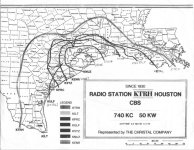KILT 610 is now transmitting from the KNTH 1070 towers, albeit with an STA for reduced power as well as an omnidirectional signal. Appears they lost use of the legacy site on West Road near I-45. New site owners finally kick them off the land? They are supposedly close to completing work on the final diplexed setup, eventually running 2.7kw days from five towers and 2.5kw nights from six towers.
STA filing states: “Audacy License LLC has been informed that the licensed facility of KILT will not be available for use after this weekend. Therefore special temporary authority for operation nondirectionally with 915 watts full time from the #1 tower (ASR 1039493) at the site of the outstanding construction permit BP-20211101AAI is requested. The filtering and detuning apparatus for the implementation of the permit facilities has been installed and tuned and nondirectional operation at this location will be straightforward. This tower is 111.7 degrees tall at 610 kHz.”
The STA request is dated February 2 and was approved today, 2/13. Direction finding at my NW Harris County location confirms the signal switch (the two sites are 90 degrees apart in direction for me, so easy to determine.)
Perhaps Chuck Tiller can fill in some more info from a KNTH perspective?
STA filing states: “Audacy License LLC has been informed that the licensed facility of KILT will not be available for use after this weekend. Therefore special temporary authority for operation nondirectionally with 915 watts full time from the #1 tower (ASR 1039493) at the site of the outstanding construction permit BP-20211101AAI is requested. The filtering and detuning apparatus for the implementation of the permit facilities has been installed and tuned and nondirectional operation at this location will be straightforward. This tower is 111.7 degrees tall at 610 kHz.”
The STA request is dated February 2 and was approved today, 2/13. Direction finding at my NW Harris County location confirms the signal switch (the two sites are 90 degrees apart in direction for me, so easy to determine.)
Perhaps Chuck Tiller can fill in some more info from a KNTH perspective?




